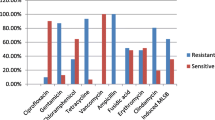Abstract
The present study was aimed at identifying a possible correlation between disease severity and colonization with superantigen-producing Staphylococcus aureus strains in patients with atopic eczema. To this end, Staphylococcus aureus strains from 91 patients with atopic eczema were screened for various staphylococcal superantigens such as SEA, SEB, SEC, SED, TSST1, the recently described enterotoxin gene cluster egc (which encodes the enterotoxins SEG, SEI, SEK, SEM, and SEO), and the see, seh, and sej loci. Swabs were taken from seven different sites in each patient. The rate of colonization with Staphylococcus aureus was 87.9%. Of those patients colonized, 35% were colonized with more than one different strain. Of the 120 genetically different strains investigated, the egc locus was found in 48.3% and the sej locus in 7.5%. The see and seh loci were not found in any strain. The presence of the classical superantigens SEA-SED or TSST1 was found in 38.3%. Overall, 71.3% of the Staphylococcus aureus-positive patients harbored at least one superantigen-producing strain on their skin. There was no difference in the prevalence of superantigens between atopic eczema patients and healthy volunteers. Moreover, there was no difference in the extent of disease expression between patients colonized by superantigen-positive Staphylococcus aureus strains and those with superantigen-negative strains as measured by the SCORAD system. However, patients colonized with Staphylococcus aureus had a significantly higher SCORAD score than those not colonized.

Similar content being viewed by others
References
Yarwood JM, Leung DYM, Schlievert PM (2000) Evidence for the involvement of bacterial superantigens in psoriasis, atopic dermatitis, and Kawasaki syndrome. FEMS Microbiol Lett 192:1–7
Skov L, Olsen JV, Giorno R, Schlievert PM, Baadsgaard O, Leung DYM (2000) Application of staphylococcal enterotoxin B on normal and atopic skin induces up-regulation of T cells by a superantigen-mediated mechanism. J Allergy Clin Immunol 105:820–826
Neuber K, Steinrücke K, Ring J (1995) Staphylococcal enterotoxin B affects in vitro IgE synthesis, interferon-γ, interleukin-4 and interleukin-5 production in atopic eczema. Int Arch Allergy Immunol 107:179–182
Strickland I, Hauk PJ, Trumble AE, Picker LJ, Leung DYM (1999) Evidence for superantigen involvement in skin homing of T cells in atopic dermatitis. J Invest Dermatol 112:249–253
Hofer MF, Harbeck RJ, Schlievert PM, Leung DYM (1999) Staphylococcal toxins augment specific IgE responses by atopic patients exposed to allergen. J Invest Dermatol 112:171–176
Bunikowski R, Mielke ME, Skarabis H, Worm M, Anagnostopoulos I, Kolde G Wahn U, Renz H (2000) Evidence for a disease-promoting effect of Staphylococcus aureus-derived exotoxins in atopic dermatitis. J Allergy Clin Immunol 105:814–819
Bunikowski R, Mielke M, Skarabis H, Herz U, Bergmann RL, Wahn U, Renz H (1999) Prevalence and role of serum IgE antibodies to the Staphylococcus aureus-derived superantigens SEA and SEB in children with atopic dermatitis. J Allergy Clin Immunol 103:119–124
Mac Fadden JP, Noble WC, Camp RD (1993) Superantigenic exotoxin-secreting potential of staphylococci from atopic eczematous skin. Br J Dermatol 128:631–632
Jappe U, Heuck D, Witte W, Gollnick H (1998) Superantigen production by Staphylococcus aureus in atopic dermatitis—no more than a coincidence. J Invest Dermatol 110:844–846
Arkwright PD, Cookson BD, Haeney MR, Sanyal D, Potter MR, David TJ (2001) Children with atopic dermatitis who carry toxin-positive Staphylococcus aureus strains have an expansion of blood CD5-B lymphocytes without an increase in disease severity. Clin Exp Immunol 125:184–189
Lina G, Cozon G, Ferrandiz J, Greenland T, Vandenesch F, Etienne J (1998) Detection of staphylococcal superantigenic toxins by a CD69-specific cytofluorimetric assay measuring T-cell activation. J Clin Microbiol 36:1042–1045
Jarraud S, Peyrat MA, Lim A, Tristan A, Bes M, Mougel C, Etienne J, Vandenesch F, Bonneville M, Lina G (2001)egc, a highly prevalent operon of enterotoxin gene, forms a putative nursery of superantigens in Staphylococcus aureus. J Immunol 166:669–677
Hanifin JM, Rajka G (1980) Diagnostic features of atopic dermatitis. Acta Derm Venereol Suppl (Stockh) 92:44–47
European Task Force on Atopic Dermatitis (1993) Severity scoring of atopic dermatitis: the SCORAD index. Consensus report of the European Task Force on Atopic Dermatitis. Dermatology 186:23–31
Zöllner TM, Wichelhaus TA, Hartung A, Von Mallinckrodt C, Wagner TO, Brade V, Kaufmann R (2000) Colonization with superantigen-producing Staphylococcus aureus is associated with increased severity of atopic dermatitis. Clin Exp Allergy 30:994–1000
Acknowledgements
This work was supported by grant no. KKF/F16–97 (M.M.) from the Technical University, Munich. Parts of this work will appear in the medical thesis of M.H.
Author information
Authors and Affiliations
Corresponding author
Rights and permissions
About this article
Cite this article
Mempel, M., Lina, G., Hojka, M. et al. High Prevalence of Superantigens Associated with the egc Locus in Staphylococcus aureus Isolates from Patients with Atopic Eczema. Eur J Clin Microbiol Infect Dis 22, 306–309 (2003). https://doi.org/10.1007/s10096-003-0928-0
Published:
Issue Date:
DOI: https://doi.org/10.1007/s10096-003-0928-0




